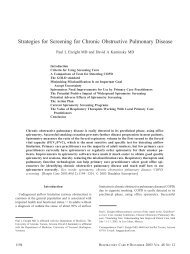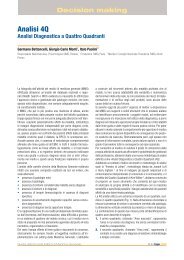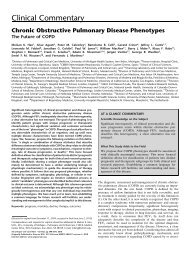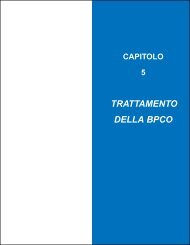Comparison of spirometry criteria for the diagnosis of COPD ... - GOLD
Comparison of spirometry criteria for the diagnosis of COPD ... - GOLD
Comparison of spirometry criteria for the diagnosis of COPD ... - GOLD
Create successful ePaper yourself
Turn your PDF publications into a flip-book with our unique Google optimized e-Paper software.
W.M. VOLLMER ET AL.<br />
<strong>COPD</strong> AND SMOKING-RELATED DISORDERS<br />
TABLE 3<br />
Prevalence <strong>of</strong> chronic obstructive pulmonary disease (<strong>COPD</strong>) computed using FEV1/FEV6 in place <strong>of</strong> FEV1/FVC<br />
Subjects n <strong>COPD</strong> criterion p-value #<br />
LLN (FEV1/FEV6) and<br />
FEV1 ,80% pred<br />
LLN (FEV1/FVC) and<br />
FEV1 ,80% pred<br />
Overall 10001 8.1 8.3 0.10<br />
Age yrs<br />
40–49 3381 4.1 4.1 0.84<br />
50–59 2968 6.5 7.2 ,0.01<br />
60–69 2172 11.2 11.5 0.57<br />
o70 1480 15.9 15.7 0.73<br />
Smoking history<br />
Never-smoker 4291 4.0 4.0 1.0<br />
0–10 pack-yrs 1777 5.0 4.8 0.66<br />
10–20 pack-yrs 1270 9.6 9.6 1.0<br />
o20 pack-yrs 2654 16.3 17.1 0.01<br />
Sex<br />
Male 4766 9.1 9.1 0.90<br />
Female 5235 7.2 7.6 0.01<br />
Site<br />
Guangzhou, China 473 6.8 5.5 0.03<br />
Adana, Turkey 806 8.3 9.3 0.04<br />
Salzburg, Austria 1258 7.2 7.5 0.34<br />
Cape Town, South Africa 847 17.1 16.3 0.25<br />
Reykjavik, Iceland 757 5.9 6.5 0.29<br />
Hanover, Germany 683 5.1 5.0 1.0<br />
Krakow, Poland 526 7.6 7.4 1.0<br />
Bergen, Norway 658 5.9 6.8 0.11<br />
Vancouver, BC, Canada 827 5.7 6.4 0.07<br />
Lexington, KY, USA 508 11.2 12.4 0.15<br />
Manila, Philippines 893 9.2 8.4 0.09<br />
Sydney, Australia 541 8.1 7.6 0.38<br />
London, UK 677 9.2 10.2 0.02<br />
Uppsala, Sweden 547 4.9 5.7 0.12<br />
Data are presented as %, unless o<strong>the</strong>rwise stated. Prevalence data are univariate classifications and not adjusted <strong>for</strong> o<strong>the</strong>r terms in <strong>the</strong> table. FEV1: <strong>for</strong>ced expiratory<br />
volume in 1 s; FEV6: <strong>for</strong>ced expiratory volume in 6 s; FVC: <strong>for</strong>ced vital capacity; LLN: lower limit <strong>of</strong> normal; % pred: % predicted. # : two-tailed exact p-values based on<br />
McNemar’s test <strong>for</strong> comparing prevalences within each subgroup.<br />
equations (4.7) was less than <strong>the</strong> Wald statistic <strong>for</strong> <strong>the</strong><br />
NHANES (9.5) and Hordaland County (8.4) equations,<br />
although all were highly statistically significant (p,0.0001).<br />
We observed similar patterns when we replaced <strong>the</strong> <strong>GOLD</strong><br />
stage 2–4 criterion with <strong>the</strong> LLN (ratio) and FEV1 ,80% pred<br />
criterion (data not shown), although <strong>the</strong> Wald statistics were<br />
closer (6.5 versus 7.3 and 8.9).<br />
Finally, <strong>the</strong> use <strong>of</strong> <strong>the</strong> FEV1/FEV6 in place <strong>of</strong> <strong>the</strong> FEV1/FVC<br />
when using <strong>the</strong> ‘‘LLN (FEV1/FVC) and FEV1 ,80% pred’’<br />
criterion had little clinically relevant impact on prevalence<br />
estimates, whe<strong>the</strong>r computed overall, by age or smoking<br />
history categories, or by site (table 3). When we did observe<br />
statistically significant differences, <strong>the</strong> prevalences were generally<br />
smaller <strong>for</strong> <strong>the</strong> FEV1/FEV6-based criterion.<br />
DISCUSSION<br />
This analysis <strong>of</strong> data from <strong>the</strong> BOLD study confirmed<br />
previously reported limitations associated with <strong>the</strong> use <strong>of</strong> <strong>the</strong><br />
fixed ratio criterion to define <strong>COPD</strong>. Adjusting <strong>the</strong> FEV1/FVC<br />
<strong>for</strong> normative ageing effects appears to reduce <strong>the</strong> rate <strong>of</strong> falsepositive<br />
diagnoses that has been reported <strong>for</strong> older individuals<br />
[2, 7–10], and <strong>the</strong> added requirement <strong>of</strong> a low FEV1 fur<strong>the</strong>r<br />
reduced <strong>the</strong> age-related increases in <strong>COPD</strong> prevalence seen<br />
among healthy never-smokers.<br />
A strength <strong>of</strong> this analysis is that data were ga<strong>the</strong>red using a<br />
standardised approach from a wide range <strong>of</strong> populations,<br />
with close attention paid to <strong>spirometry</strong> quality control. The<br />
qualitative similarity <strong>of</strong> results across sites (fig. 1a) provides<br />
strong evidence <strong>for</strong> <strong>the</strong> robustness <strong>of</strong> our findings. The wide<br />
variation in characteristics <strong>of</strong> BOLD sites enabled us to use<br />
site-to-site variation in prevalence (assessed using <strong>the</strong> Wald<br />
statistic) as a convenient metric <strong>for</strong> comparing alternative<br />
measures <strong>of</strong> <strong>COPD</strong> prevalence, since a desired characteristic<br />
<strong>of</strong> any prevalence estimate is that it yields comparable<br />
estimates in different populations after adjusting <strong>for</strong> known<br />
risk factors.<br />
c<br />
EUROPEAN RESPIRATORY JOURNAL VOLUME 34 NUMBER 3 593



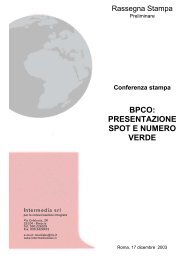
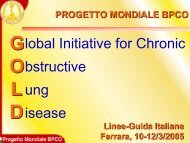
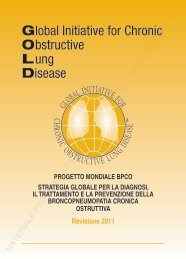
![Di Bari [NO].pdf - GOLD](https://img.yumpu.com/21544924/1/190x143/di-bari-nopdf-gold.jpg?quality=85)


